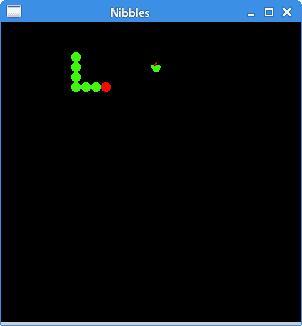在 Java SWT 教程的这一部分中,我们创建了贪食蛇游戏克隆。
贪食蛇是较旧的经典视频游戏。 它最初是在 70 年代后期创建的; 后来它被带到 PC 上。 在此游戏中,玩家控制蛇。 目的是尽可能多地吃苹果。 蛇每次吃一个苹果,它的身体就会长大。 蛇必须避开墙壁和自己的身体。
开发
蛇的每个关节的大小为 10 像素。 蛇由光标键控制。 最初,蛇具有三个关节。 游戏立即开始。 游戏结束后,窗口中央将显示"Game Over"消息。
Board.java
package com.zetcode;import org.eclipse.swt.SWT;import org.eclipse.swt.graphics.Color;import org.eclipse.swt.graphics.Font;import org.eclipse.swt.graphics.GC;import org.eclipse.swt.graphics.Image;import org.eclipse.swt.graphics.ImageData;import org.eclipse.swt.graphics.Point;import org.eclipse.swt.widgets.Canvas;import org.eclipse.swt.widgets.Display;import org.eclipse.swt.widgets.Event;import org.eclipse.swt.widgets.Shell;public class Board extends Canvas {private final int WIDTH = 300;private final int HEIGHT = 300;private final int DOT_SIZE = 10;private final int ALL_DOTS = 900;private final int RAND_POS = 29;private final int DELAY = 140;private int x[] = new int[ALL_DOTS];private int y[] = new int[ALL_DOTS];private int dots;private int apple_x;private int apple_y;private boolean left = false;private boolean right = true;private boolean up = false;private boolean down = false;private boolean inGame = true;private Image ball;private Image apple;private Image head;private Display display;private Shell shell;private Runnable runnable;public Board(Shell shell) {super(shell, SWT.NULL);this.shell = shell;initBoard();}private void initBoard() {display = shell.getDisplay();addListener(SWT.Paint, event -> doPainting(event));addListener(SWT.KeyDown, event -> onKeyDown(event));addListener(SWT.Dispose, event -> {ball.dispose();apple.dispose();head.dispose();});Color col = new Color(shell.getDisplay(), 0, 0, 0);setBackground(col);col.dispose();loadImages();initGame();}private void loadImages() {ImageData iib = new ImageData("dot.png");ball = new Image(display, iib);ImageData iia = new ImageData("apple.png");apple = new Image(display, iia);ImageData iih = new ImageData("head.png");head = new Image(display, iih);}private void initGame() {dots = 3;for (int z = 0; z < dots; z++) {x[z] = 50 - z * 10;y[z] = 50;}locateApple();runnable = new Runnable() {@Overridepublic void run() {if (inGame) {checkApple();checkCollision();move();}display.timerExec(DELAY, this);redraw();}};display.timerExec(DELAY, runnable);};private void doPainting(Event e) {GC gc = e.gc;Color col = new Color(shell.getDisplay(), 0, 0, 0);gc.setBackground(col);col.dispose();gc.setAntialias(SWT.ON);if (inGame) {drawObjects(e);} else {gameOver(e);}}private void drawObjects(Event e) {GC gc = e.gc;gc.drawImage(apple, apple_x, apple_y);for (int z = 0; z < dots; z++) {if (z == 0) {gc.drawImage(head, x[z], y[z]);} else {gc.drawImage(ball, x[z], y[z]);}}}private void gameOver(Event e) {GC gc = e.gc;String msg = "Game Over";Font font = new Font(e.display, "Helvetica", 12, SWT.NORMAL);Color whiteCol = new Color(e.display, 255, 255, 255);gc.setForeground(whiteCol);gc.setFont(font);Point size = gc.textExtent(msg);gc.drawText(msg, (WIDTH - size.x) / 2, (HEIGHT - size.y) / 2);font.dispose();whiteCol.dispose();display.timerExec(-1, runnable);}private void checkApple() {if ((x[0] == apple_x) && (y[0] == apple_y)) {dots++;locateApple();}}private void move() {for (int z = dots; z > 0; z--) {x[z] = x[(z - 1)];y[z] = y[(z - 1)];}if (left) {x[0] -= DOT_SIZE;}if (right) {x[0] += DOT_SIZE;}if (up) {y[0] -= DOT_SIZE;}if (down) {y[0] += DOT_SIZE;}}public void checkCollision() {for (int z = dots; z > 0; z--) {if ((z > 4) && (x[0] == x[z]) && (y[0] == y[z])) {inGame = false;}}if (y[0] > HEIGHT - DOT_SIZE) {inGame = false;}if (y[0] < 0) {inGame = false;}if (x[0] > WIDTH - DOT_SIZE) {inGame = false;}if (x[0] < 0) {inGame = false;}}public void locateApple() {int r = (int) (Math.random() * RAND_POS);apple_x = ((r * DOT_SIZE));r = (int) (Math.random() * RAND_POS);apple_y = ((r * DOT_SIZE));}private void onKeyDown(Event e) {int key = e.keyCode;if ((key == SWT.ARROW_LEFT) && (!right)) {left = true;up = false;down = false;}if ((key == SWT.ARROW_RIGHT) && (!left)) {right = true;up = false;down = false;}if ((key == SWT.ARROW_UP) && (!down)) {up = true;right = false;left = false;}if ((key == SWT.ARROW_DOWN) && (!up)) {down = true;right = false;left = false;}}}
首先,我们将定义一些在游戏中使用的全局变量。
WIDTH和HEIGHT常数确定电路板的大小。 DOT_SIZE是苹果的大小和蛇的点。 ALL_DOTS常数定义了板上可能的最大点数。 RAND_POS常数用于计算苹果的随机位置。 DELAY常数确定游戏的速度。
private int x[] = new int[ALL_DOTS];private int y[] = new int[ALL_DOTS];
这两个数组存储蛇的所有可能关节的 x 和 y 坐标。
initGame()方法初始化变量,加载图像并启动超时功能。
runnable = new Runnable() {@Overridepublic void run() {if (inGame) {checkApple();checkCollision();move();}display.timerExec(DELAY, this);redraw();}};
每隔DELAY ms,将调用run()方法。 如果我们参与了游戏,我们将调用三种构建游戏逻辑的方法。
if (inGame) {drawObjects(e);} else {gameOver(e);}
在doPainting()方法内部,我们检查inGame变量。 如果是真的,我们将绘制对象-苹果和蛇关节。 否则,我们显示"Game Over"文本。
private void drawObjects(Event e) {GC gc = e.gc;gc.drawImage(apple, apple_x, apple_y);for (int z = 0; z < dots; z++) {if (z == 0) {gc.drawImage(head, x[z], y[z]);} else {gc.drawImage(ball, x[z], y[z]);}}}
drawObjects()方法绘制苹果和蛇的关节。 蛇的第一个关节是其头部,用红色圆圈表示。
public void checkApple() {if ((x[0] == apple_x) && (y[0] == apple_y)) {dots++;locateApple();}}
checkApple()方法检查蛇是否击中了苹果对象。 如果是这样,我们添加另一个蛇形关节并调用locateApple()方法,该方法将随机放置一个新的Apple对象。
在move()方法中,我们有游戏的关键算法。 要了解它,请看一下蛇是如何运动的。 您控制蛇的头。 您可以使用光标键更改其方向。 其余关节在链上向上移动一个位置。 第二关节移动到第一个关节的位置,第三关节移动到第二个关节的位置,依此类推。
for (int z = dots; z > 0; z--) {x[z] = x[(z - 1)];y[z] = y[(z - 1)];}
该代码将关节向上移动。
if (left) {x[0] -= DOT_SIZE;}
将头向左移动。
在checkCollision()方法中,我们确定蛇是否击中了自己或撞墙之一。
for (int z = dots; z > 0; z--) {if ((z > 4) && (x[0] == x[z]) && (y[0] == y[z])) {inGame = false;}}
如果蛇用头撞到关节之一,我们就结束游戏。
if (y[0] > HEIGHT - DOT_SIZE) {inGame = false;}
如果蛇击中了棋盘的底部,我们就结束了游戏。
locateApple()方法在板上随机放置一个苹果。
int r = (int) (Math.random() * RAND_POS);
我们得到一个从 0 到RAND_POS-1的随机数。
apple_x = ((r * DOT_SIZE));...apple_y = ((r * DOT_SIZE));
这些行设置了apple对象的 x 和 y 坐标。
在onKeyDown()方法中,我们确定按下的键。
if ((key == SWT.ARROW_LEFT) && (!right)) {left = true;up = false;down = false;}
如果按左光标键,则将left变量设置为true。 在move()方法中使用此变量来更改蛇对象的坐标。 还要注意,当蛇向右行驶时,我们不能立即向左转。
Nibbles.java
package com.zetcode;import org.eclipse.swt.SWT;import org.eclipse.swt.layout.FillLayout;import org.eclipse.swt.widgets.Display;import org.eclipse.swt.widgets.Shell;/*** ZetCode Java SWT tutorial** In this code example, we create* a Nibbles game clone** Author: Jan Bodnar* Website: zetcode.com* Last modified: June 2015*/public class Nibbles {private final int WIDTH = 300;private final int HEIGHT = 300;public Nibbles(Display display) {initUI(display);}@SuppressWarnings("unused")private void initUI(Display display) {Shell shell = new Shell(display, SWT.SHELL_TRIM | SWT.CENTER);FillLayout layout = new FillLayout();shell.setLayout(layout);Board board = new Board(shell);shell.setText("Nibbles");int borW = shell.getSize().x - shell.getClientArea().width;int borH = shell.getSize().y - shell.getClientArea().height;shell.setSize(WIDTH + borW, HEIGHT + borH);shell.open();while (!shell.isDisposed()) {if (!display.readAndDispatch()) {display.sleep();}}}@SuppressWarnings("unused")public static void main(String[] args) {Display display = new Display();Nibbles ex = new Nibbles(display);display.dispose();}}
在这个类中,我们设置了贪食蛇游戏。
int borW = shell.getSize().x - shell.getClientArea().width;int borH = shell.getSize().y - shell.getClientArea().height;shell.setSize(WIDTH + borW, HEIGHT + borH);
在设置外壳大小时,我们还需要考虑窗口装饰。

图:贪食蛇
这是使用 SWT 库和 Java 编程语言编程的贪食蛇电脑游戏。

